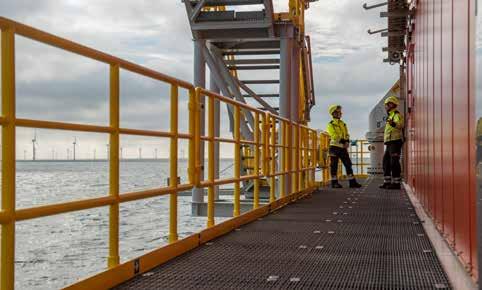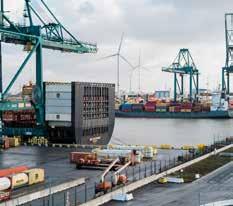
7 minute read
C. THERMAL GENERATION MODELLING
This appendix details first the general approach of thermal generation in the Antares simulator and gives then detailed information on how it is applied for Belgium and other EU countries in the Adequacy and Flexibility study 2023.
C.1. GENERAL APPROACH
Regarding thermal generation, two modelling methods are applied:
• Dispatchable thermal generation – the unit will generate according to the most economical dispatch (as explained in this appendix). Its final production is an output of the simulation;
• Profiled thermal generation – the production of the unit is fixed before the simulation (must-run).
The following parameters are required for both dispatchable and profiled thermal generation in order for Antares to run the unit commitment and economic dispatch calculation:
• the number of units, the nominal capacities defining the installed capacities for each hour;
• the cost, including a variable cost and a start-up cost; Other parameters are only relevant for dispatchable thermal units:
• the parameters associated to the availability of units, including forced outage rate and duration, planned outage rate and duration and the planned outage minimum and maximum amounts for each day (see also Section 4 of this appendix);
• the technical constraints for minimum stable power, mustrun (partial), minimum up and down durations.
Concerning the technical constraints for must-run, two values can be used: a value considered only if the plant is switched on (minimum stable power) and a value which, if higher than null, forbids the plant from being switched off in the dispatch (must-run). The latter is given on an hourly step time base, whereas the former is a single value for the whole simulation.
The variable cost of each unit is determined through a set of parameters including the efficiency, the variable and operating maintenance cost and commodity prices (CO2 price, fuel price). The efficiency of each thermal unit is considered independent of the loading of the unit even though it depends in reality on the generated power.
The installed capacity for each hour and the parameters associated to the availability of units are used to generate the time series of available capacity.
C.2. MODELLING APPROACH FOR BELGIUM
For Belgium, both dispatchable and profiled thermal generation is used:
• larger units which are usually directly connected to Elia grid are modelled individually as dispatchable thermal generation;
• smaller units which are usually decentralised units connected to the distribution grid, are aggregated into profiled thermal generation (with production fixed before the simulation – considered as a must-run unit).
The approach used for Belgium in this AdeqFlex’23 study is the same as the one used in the previous AdeqFlex’21 study.
For the dispatchable thermal generation each unit is modelled individually. Their production is determined by the economic dispatch simulation.
Some of these units also operate to fulfill side processes.
This includes gas-fired units that act as combined heat and power (CHP) units, as well as biofuel-fired units such as biomass and waste facilities. Therefore, in order to account for the historical behavior of those units (and especially in case of low prices), the following constraints are added:
• the dispatch of individually modelled gas-fired CHP units is bounded with a partial must run of 60% of their capacity;

• the dispatch of individually modelled biofuel-fired units is bounded with a must run of 100% (the must run is corresponding to the full capacity).
Based on historical data, it can be observed that large gasfired CHP units can be dispatched at full capacity in case of high prices but that the average capacity factor remains lower. This indicates that the side process associated with CHP units can potentially influence dispatch decisions, leading to the possibility of overestimating their actual contribution to adequacy if the model allows them to operate at full capacity. This observation is illustrated on Figure C-1 which examines historical data from 2016 to 2022. It shows that even during periods of high prices, the average capacity factor remains around 70%.
The Normalised Belgian market zone price in Figure C-1 refers to the deviation of the hourly price with the monthly average price for Belgium.
In the case of individually modeled biofuel-fired units, the historical analysis has indicated that they can also be dispatched at full capacity. However, the average capacity factor is relatively higher compared to gas-fired CHP units. This suggests that the side process associated with biofuel-fired units (if any) has a lesser impact on dispatch decisions when operating at 100% of the installed capacity. This can also be explained by the fact that those units receive subsidies that encourage them to maximise their output. This is illustrated on Figure C-2. The Normalised Belgian market zone price in the figure refers to the deviation of the hourly price with the monthly average price for Belgium.
FIGURE C-2 — COMPARISON BETWEEN ELECTRICITY PRICES AND CAPACITY FACTORS OF INDIVIDUALLY MODELLED BIOFUEL-FIRED UNITS IN BELGIUM OVER 2016-2022
For the profiled thermal generation whose generation is pre-fixed in the simulations (fully must-run, independent of the economic dispatch), two distinct profiles are used for
• Aggregated profiled Combined Heat & Power (CHP) units;
• Aggregated profiled biomass and waste units.
For the aggregated profiled biomass and waste units, the latest analysis of the measurement data has shown no clear seasonal trend. A constant production profile is therefore used, it amounts to a 60% capacity factor, based on historical data.
In the case of aggregated profiled CHP units the available power output measurement data is analysed. A correlation analysis on the relation between the production of these units and the corresponding daily temperature, load and electricity price showed a clear seasonal trend. As no significant difference in aggregated behavior between the CHP categories (turbine and motors) is discovered in terms of load factor or seasonal correlation, both categories are combined into a single generation profile.
The average hourly profile for a week in winter based on historical data is illustrated on Figure C-3. The figure also includes minimum and maximum values. Note that given the correlation of the profile with the temperature, a different profile is used for each of the 200 climate years used in this AdeqFlex’23 study. Figure C-4 illustrates the historical seasonality of the profile.
FIGURE C-3 — AVERAGE, MIN AND MAX HISTORICAL WEEKLY PROFILES DURING WINTER OF AGGREGATED CHP UNITS GENERATION IN BELGIUM
The same analysis of the correlation between the electricity prices and the capacity factors of aggregated profiled CHP units in Belgium has been performed on the period 2018-2022 (Figure C-5). It shows that those units are not dispatched at the full capacity in case of higher prices (maximum around 80%).
The Normalised Belgian market zone price in the figure refers to the deviation of the hourly price with the monthly average price for Belgium.
1 Baseload generation of about 30%
2 Capacity factor between 50 and 85% in case of high prices, with constant moving average Units not dispatched at full capacity even with very high normalised prices
3 Moving average shows limited price - capacity factor dependence
Linear increase of the capacity factor from 50 to 70%.
C.3. MODELLING APPROACH FOR OTHER EU COUNTRIES
For the others countries, both dispatchable and profiled thermal generation are also considered.
Regarding the dispatchable thermal generation, an equilibrium has to be found between a very detailed (but heavy) model with all individual units being modelled and the aggregation of smaller units that leads to a lighter model with shorter running time. For some countries, there are more than 500 units of less than 100 MW. Modelling each of those units individually has an important impact on the simulation time. In such a case the smaller units are aggregated into clusters without losing economic or dispatch information. A cluster is a single power plant or a group of power plants with similar characteristics. For example, if 2 units of 50 MW have the same marginal price and other economic parameters, they are added to a cluster considering 2 units of 50 MW. This eases the computation time but does not remove economic dispatch information from the model.
A distinction is made between neighboring countries where a higher granularity is kept to allow unit per unit follow-up for large units and non-neighboring countries where more aggregation is done.
• Neighboring countries (Netherlands Germany, France, Great Britain):
• All units below 200 MW are aggregated if they show the same characteristics (same fuel, same unit type, … leading to same marginal price);
• All units above 200 MW are individually modelled.
• Non neighboring countries:
• Units with the same marginal price and other economic/ technical parameters are aggregated into one dispatchable cluster containing the amount of units that were aggregated. This approach allows simplifying the equations of the model while keeping all the required economic information.
C.4. AVAILABILITY MODELLING OF INDIVIDUALLY MODELLED THERMAL UNITS
The availability of thermal units is modelled in Antares as a daily three-state Markov chain for each unit, with the three states being available (A), planned outage (PO) and forced outage (FO). This means that each unit can only be in one of these three states at a given time, and the probability of moving to a different state depends on the chances of staying in the current state or moving to one of the other two states. A visual representation is shown on the left side of Figure C-6. The exact outage rates for each unit are provided in the main report.
For the years 2023-2025 future planned outages are already available on the ENTSO-E transparency platform (REMIT data). This enables modelling the unavailability of a power plant more accurately since one of the three states is already known. Using this information, the overall outage pattern was recalculated, starting from the given state of the planned outages, and given this state calculating the forced outages. This methodology is used for all units where planned outage data was available.
For nuclear units in Belgium, a fourth state is added: ‘long-lasting’ forced outage, a visual representation is shown in Figure C-6. This fourth state is added because for Belgian nuclear units some exceptional outage events were observed that would not fit in the planned or forced outages category due to their longer duration and different frequency. A more in-depth explanation can be found in the main report. These long-lasting forced outages are modelled the same way as normal planned and forced outages, but with a different outage rate and outage duration.
FIGURE C-6 — VISUAL REPRESENTATION OF A MARKOV CHAIN
Three-state



